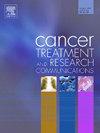Long-term results of a randomized controlled trial of biosimilar CT-P16 and reference bevacizumab in patients with metastatic or recurrent non-small cell lung cancer
IF 2.4
Q3 Medicine
引用次数: 0
Abstract
Purpose
Data from the CT-P16 3.1 study demonstrated equivalent efficacy between CT-P16, a bevacizumab biosimilar, and European-approved reference bevacizumab (EU-bevacizumab) for the primary endpoint of objective response rate (ORR) during induction treatment in patients with metastatic or recurrent non-squamous non-small cell lung cancer (NSCLC). We now present long-term findings.
Methods
In this randomized, double-blind, multicenter phase 3 study, patients with metastatic or recurrent non-squamous NSCLC received CT-P16 or EU-bevacizumab (15 mg/kg every 3 weeks; ≤6 cycles) together with paclitaxel (200 mg/m2) and carboplatin (area under the curve 6.0) for 4–6 cycles during the induction period. Patients with controlled disease entered the maintenance period, continuing with CT-P16 or EU-bevacizumab as monotherapy until disease progression/intolerable toxicity. They were then followed up every 9 weeks until death or end of study. Outcomes were evaluated ≤3 years after the last patient enrollment.
Results
Of 689 patients receiving CT-P16 (N = 342) or EU-bevacizumab (N = 347), 499 (72.4 %) completed the induction period (CT-P16, n = 258 [75.4 %]; EU-bevacizumab, n = 241 [69.5 %]), 466 (67.6 %) initiated the maintenance period (CT-P16, n = 239 [69.9 %]; EU-bevacizumab, n = 227 [65.4 %]), and 389 (56.5 %) entered follow-up (CT-P16, n = 190 [55.6 %]; EU-bevacizumab, n = 199 [57.3 %]). Whole study ORRs were similar for CT-P16 (45.61 % [95 % confidence interval 40.34–50.89]) and EU-bevacizumab (46.11 % [95 % confidence interval 40.86–51.35]). Response duration, time to progression, progression-free survival, and overall survival were similar. No new safety signals were detected.
Conclusions
Long-term results of the CT-P16 3.1 study confirm equivalent efficacy of CT-P16 and EU-bevacizumab in patients with metastatic or recurrent non-squamous NSCLC.
Trial registration number
NCT03676192.
Micro abstract
Equivalent efficacy between CT-P16, a bevacizumab biosimilar, and European-approved reference bevacizumab (EU-bevacizumab) was demonstrated in a phase 3 study of patients with metastatic or recurrent non-squamous NSCLC. Long-term findings in 689 patients confirmed equivalent efficacy of CT-P16 and EU-bevacizumab; objective response rates were 45.6 % and 46.1 %, respectively. Response duration, time to progression, progression-free survival, and overall survival were also similar.
生物仿制药CT-P16和参比贝伐单抗在转移性或复发性非小细胞肺癌患者中的长期随机对照试验结果
来自CT-P16 3.1研究的数据表明,在转移性或复发性非鳞状非小细胞肺癌(NSCLC)诱导治疗期间,CT-P16(贝伐珠单抗生物类似药)和欧洲批准的参考贝伐珠单抗(eu -贝伐珠单抗)在客观缓解率(ORR)的主要终点方面的疗效相当。我们现在提出长期的研究结果。在这项随机、双盲、多中心的3期研究中,转移性或复发性非鳞状NSCLC患者接受CT-P16或eu -贝伐单抗治疗(15mg /kg / 3周;≤6个周期),诱导期与紫杉醇(200mg /m2)、卡铂(曲线下面积6.0)联合使用4-6个周期。疾病得到控制的患者进入维持期,继续使用CT-P16或eu -贝伐单抗作为单药治疗,直到疾病进展/无法忍受的毒性。然后每9周随访一次,直到死亡或研究结束。在最后一次患者入组后≤3年评估结果。结果689例接受CT-P16 (N = 342)或eu -贝伐单抗(N = 347)治疗的患者中,499例(72.4%)完成了诱导期(CT-P16, N = 258 [75.4%];eu -贝伐单抗,n = 241[69.5%]), 466(67.6%)开始维持期(CT-P16, n = 239 [69.9%];eu -贝伐单抗,n = 227[65.4%]), 389(56.5%)进入随访(CT-P16, n = 190 [55.6%];EU-bevacizumab, n = 199[57.3%])。整个研究的orr与CT-P16(45.61%[95%置信区间40.34-50.89])和eu -贝伐单抗(46.11%[95%置信区间40.86-51.35])相似。反应持续时间、进展时间、无进展生存期和总生存期相似。没有检测到新的安全信号。结论CT-P16 3.1研究的长期结果证实,CT-P16和eu -贝伐单抗在转移性或复发性非鳞状NSCLC患者中的疗效相当。试验注册号:bernct03676192。在一项针对转移性或复发性非鳞状NSCLC患者的3期研究中,贝伐珠单抗生物类似药CT-P16和欧洲批准的参比贝伐珠单抗(eu -贝伐珠单抗)之间的等效疗效得到证实。689例患者的长期研究结果证实CT-P16和eu -贝伐单抗的疗效相当;客观有效率分别为45.6%和46.1%。反应持续时间、进展时间、无进展生存期和总生存期也相似。
本文章由计算机程序翻译,如有差异,请以英文原文为准。
求助全文
约1分钟内获得全文
求助全文
来源期刊

Cancer treatment and research communications
Medicine-Oncology
CiteScore
4.30
自引率
0.00%
发文量
148
审稿时长
56 days
期刊介绍:
Cancer Treatment and Research Communications is an international peer-reviewed publication dedicated to providing comprehensive basic, translational, and clinical oncology research. The journal is devoted to articles on detection, diagnosis, prevention, policy, and treatment of cancer and provides a global forum for the nurturing and development of future generations of oncology scientists. Cancer Treatment and Research Communications publishes comprehensive reviews and original studies describing various aspects of basic through clinical research of all tumor types. The journal also accepts clinical studies in oncology, with an emphasis on prospective early phase clinical trials. Specific areas of interest include basic, translational, and clinical research and mechanistic approaches; cancer biology; molecular carcinogenesis; genetics and genomics; stem cell and developmental biology; immunology; molecular and cellular oncology; systems biology; drug sensitivity and resistance; gene and antisense therapy; pathology, markers, and prognostic indicators; chemoprevention strategies; multimodality therapy; cancer policy; and integration of various approaches. Our mission is to be the premier source of relevant information through promoting excellence in research and facilitating the timely translation of that science to health care and clinical practice.
 求助内容:
求助内容: 应助结果提醒方式:
应助结果提醒方式:


